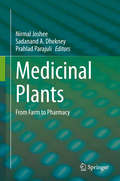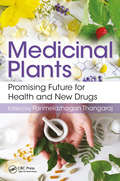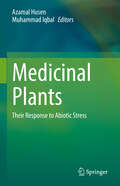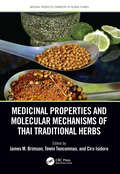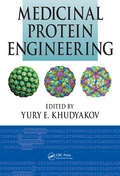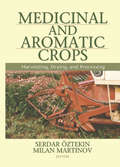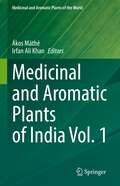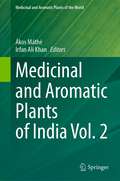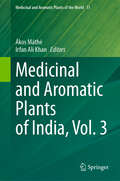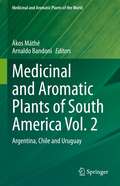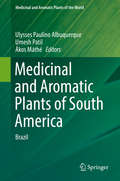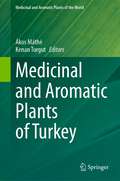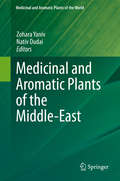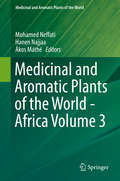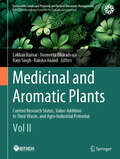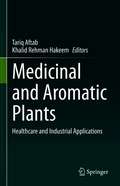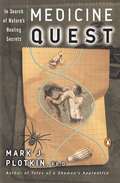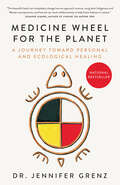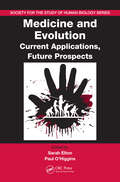- Table View
- List View
Medicinal Plants: From Farm to Pharmacy
by Nirmal Joshee Sadanand A. Dhekney Prahlad ParajuliThis book offers a fresh look on a variety of issues concerning herbal medicine - the methods of growing and harvesting various medicinal plants; their phytochemical content; medicinal usage; regulatory issues; and mechanism of action against myriad of human and animal ailments. ‘Medicinal Plants: From Farm to Pharmacy’ comprises chapters authored by renowned experts from academics and industry from all over the world. It provides timely, in-depth study/analysis of medicinal plants that are already available in the market as supplements or drug components, while also introducing several traditional herbs with potential medicinal applications from various regions of the world. The book caters to the needs of a diverse group of readers: plant growers, who are looking for ways to enhance the value of their crops by increasing phytochemical content of plant products; biomedical scientists who are studying newer applications for crude herbal extracts or isolated phytochemicals; clinicians and pharmacologists who are studying interactions of herbal compounds with conventional treatment modalities; entrepreneurs who are navigating ways to bring novel herbal supplements to the market; and finally, natural medicine enthusiasts and end-users who want to learn how herbal compounds are produced in nature, how do they work and how are they used in traditional or modern medicine for various disease indications.
Medicinal Plants: Promising Future for Health and New Drugs
by Parimelazhagan ThangarajThis book highlights the importance of traditional medicines, focuses on the standardization of herbal medicine and evaluates opportunities for advancing drug research. It addresses issues in utilization of medicinal plants and shares the importance of herbs in neutraceutics. It provides most competitive techniques being used in research.
Medicinal Plants: Their Response to Abiotic Stress
by Muhammad Iqbal Azamal HusenThis book provides a comprehensive overview of medicinal plants and their interaction with abiotic stress in terms of morphological, physiological, biochemical, and molecular variations, and explains the adaptation and tolerance mechanisms involved. It presents various mechanisms that become operative in medicinal plants to combat stressful situations. The book discusses the secondary metabolites and/or bioactive compounds produced in medicinal plants under abiotic stress conditions, and the use of biostimulants and/or phytoprotectants to alleviate the adverse effects of abiotic stresses on medicinal plants. Additionally, it is likely to address opportunities and challenges in molecular and omics studies of medicinal plants under abiotic stress conditions. Overall, the chapters are developed by eminent subject experts with due care and clarity and cover an up-to-date literature review with relevant illustrations. The book would cater to the need of graduate and post-graduate students, researchers as well as scientists, and may attract the attention of pharmaceutical companies/industrialists and health policymakers.
Medicinal Properties and Molecular Mechanisms of Thai Traditional Herbs (Natural Products Chemistry of Global Plants)
by James M. Brimson, Tewin Tencomnao, and Ciro IsidoroWith a focus on the unique cultural and ecological of aspects of Thailand, this latest title in the popular series, Natural Products Chemistry of Global Plants, offers invaluable insights for researchers and healthcare professionals interested in exploring the potential of Thai herbal medicines in the broader context of global health and wellness. It also appeals to individuals seeking natural and traditional alternatives to modern medicine. The book provides a bridge between modern pharmacology and traditional medicinal practices, thereby bringing Thai traditional herbal medicines into the mainstream, while giving a critical explanation of their efficacy and safety.
Medicinal Protein Engineering
by Yury E. KhudyakovAn All-Inclusive Review of the Achievements and Trends in the Fast-Growing Protein Engineering Field From humble beginnings like making fire for mere survival, engineering now steadfastly penetrates all aspects of our lives and even life itself at the molecular level. Protein engineering is a molecular biological discipline focused on designing and
Medicinal Roots and Tubers for Pharmaceutical and Commercial Applications (Exploring Medicinal Plants)
by Rakesh Kumar Bachheti and Archana BachhetiThe root and tuber are vital parts of medicinal plants providing mechanical support, producing critical growth regulators, and storing food. Bioactive compounds obtained from plant roots and tubers demonstrate health benefits presenting antioxidative, antimicrobial, hypoglycaemic, hypocholesterolaemic, and immunomodulatory properties. Roots of many medicinal plants have been used for the treatment of disease and formulation of drugs, and they are also known for their commercial value, being used as an ingredient in the pharmaceutical and cosmetic industries. Medicinal Roots and Tubers for Pharmaceutical and Commercial Applications provides information on the medicinal properties of roots and tubers and various phytochemicals derived from them. Features Presents exhaustive information on plant roots and tubers including Glycyrrhiza glabra, Curcuma longa, Beta vulgaris, Zingiber officinalis, Boesenbergia pandurata, Houttuynia cordata, Eutrema japonicum, and Withania somnifera Explains the roles of secondary metabolites isolated from roots and tubers and features information on their pharmaceutical and commercial applications Discusses opportunities for future prospects of different roots and tubers for their industrial applications A volume in the Exploring Medicinal Plants series, this book provides information on phytochemicals derived from medicinal plant roots and tubers. This is valuable information for scientists, researchers, and students working on medicinal plants, economic botany, chemistry, biotechnology, pharmaceuticals, and many other interdisciplinary subjects.
Medicinal Spice and Condiment Crops (Exploring Medicinal Plants)
by Azamal HusenSpices are used in small quantities to add flavor, aroma, color, and texture in food preparation. However, spices and condiments have also been recognized as having medicinal value. They have been used traditionally as curative and preventive agents, the bioactive compounds obtained from these plants are used in herbal drug formulations in modern times. Medicinal Spice and Condiment Crops provides a comprehensive overview on the medicinal properties of spices and condiments with focus on various phytochemicals derived from them.KEY FEATURES:• Examines spices and condiments with respect to their biology, diversity, distribution, and pharmacological values.• Explores the scientific validations of the therapeutic potentials of spice and condiment plant species.• Discusses the bioactive agents involved in alleviating symptoms of cardiovascular disease, cancer, diabetes, ulcers, skin disorders, and neurodegenerative diseases.• Explains specific medicinal features of spice and condiment-producing plant species inspiring research, discovery, and safe herbal drug formulation.A volume in the Exploring Medicinal Plants series, this book is useful for plant scientists, economic botanists, those who work with herbal and complementary medicine, as well as people working in the pharmaceutical industry.
Medicinal and Aromatic Crops: Harvesting, Drying, and Processing
by Serdar Oztekin Milan MartinovMake sure your crops are market-ready with the aid of harvest and post-harvest mechanization Medicinal and Aromatic Crops presents harvest and post-harvest mechanization methods for the profitable production of market-ready medicinal crops. This practical handbook includes photos, detailed figures, and schematic drawings of machines tha
Medicinal and Aromatic Plants of India Vol. 1 (Medicinal and Aromatic Plants of the World #8)
by Ákos Máthé Irfan Ali KhanThis book is the 8th volume of the popular series ‘Medicinal and Aromatic Plants of the World’. Like the previous volumes, this volume is being introduced in a monographic format containing an extremely rich and diverse medicinal flora of India. Both well-known and somewhat still ignored species have been described in view of their traditional, present day and prospective uses. The scientific and technological achievements are also included aptly in this volume, together with a careful and critical consideration to our contemporary knowledge of this vast interdisciplinary domain with an Indian focus. In the era of global climate change and pandemics, building on the huge Indian traditions, this volume will make an important contribution to the better knowledge and understanding of MAPs. The Indian flora has always been recognized for its medicinal and aromatic plant values and this volume is explicitly focusing in that direction. With the rapidly expanding scope of natural nutraceuticals and herbal formulations, this book will be a fruitful acquisition for the interested readers globally.
Medicinal and Aromatic Plants of India Vol. 2 (Medicinal and Aromatic Plants of the World #9)
by Ákos Máthé Irfan Ali KhanThis book is the 9th volume in the series Medicinal and Aromatic Plants of the World. India being one of the countries with the longest and richest past/present/future of Medicinal and Aromatic Plant (MAP) production and utilization has accumulated more than sufficient knowledge to fill two volumes. This is shown by the vivid interest of Indian colleagues to contribute. Similar to the previous volumes, this one deals with the various important aspects (from botanical through phytochemical to pharmacological) of MAPs', famous or simply known of India. Scientific and technological achievements will be equally presented.In addition to the first volume, India V1, this volume is aimed to look carefully at our present knowledge of this vas interdisciplinary domain with an Indian focus. In the era of global climate change and pandemics, building on the huge Indian traditions, this book is expected to make an important contribution to the better knowledge and understanding of MAPs.
Medicinal and Aromatic Plants of India, Vol. 3 (Medicinal and Aromatic Plants of the World #11)
by Ákos Máthé Irfan Ali KhanThis book is the 11th volume of the popular series "Medicinal and Aromatic Plants of the World". It is a comprehensive compilation of 30 chapters on selected important species representative of India's rich and diverse flora. This collection provides current scientific information highlighting the traditional, contemporary, and prospective uses of both well-known and lesser-known plant species. The volume serves as a bridge between traditional knowledge and modern scientific advancements, providing a critical analysis of this broad interdisciplinary field with a particular focus on India. The chapters cover topics such as the pharmacological properties, biochemical composition, and therapeutic applications of these plants. Readers will find contributions by renowned scholars who delve into the innovative product development stemming from the ancient medicinal plant systems. Particular attention is given to how these plants can contribute to health and wellness in the era of global climate change and pandemics. This book invites readers to face critical questions about the survival and utilization of medicinal and aromatic plants in India. Researchers, scholars, and practitioners in fields of botany, pharmacology, and traditional medicine will find this volume invaluable. It is also an essential resource for anyone interested in botanicals, plant-based nutraceuticals and herbal formulations. Whether you are an academic or a professional working in the field of medicinal plants, this book offers a wealth of knowledge that bridges rich ancient traditions with modern science.
Medicinal and Aromatic Plants of North America (Medicinal and Aromatic Plants of the World #6)
by Ákos MáthéThis volume is aimed at offering an insight into the present knowledge of the vast domain of Medicinal and Aromatic Plants with a focus on North America. In this era of global climate change the volume is meant to provide an important contribution to a better understanding of the diverse world of Medicinal and Aromatic Plant research, production and utilization.
Medicinal and Aromatic Plants of South America Vol. 2: Argentina, Chile and Uruguay (Medicinal and Aromatic Plants of the World #7)
by Ákos Máthé Arnaldo BandoniThis volume, as the seventh of the series Medicinal and Aromatic Plants of the World, deals with the medicinal and aromatic plant (MAPs) treasures of the so-called Southern Cone, the three southernmost countries (Argentina, Chile and Uruguay) of South America. Similarly to the previous volumes of the series, the main focus is to collect and provide information on major aspects of botany, traditional usage, chemistry, production / collection practices, trade and utilization of this specific group of plants. The contributors, who are recognized professionals and specialist of the domain, have collected and present state of the art information on 41 species. Most of these are not only of interest from the scientific point of view, but hold also a potential for the prospective utilization of the decreasing, occasionally overexploited / endangered medicinal plant resources of this huge continent. The book is expected to serve as a source of information also on some less known or less studied species. As such the volume is expected to support future research and public health professionals.
Medicinal and Aromatic Plants of South America: Brazil (Medicinal and Aromatic Plants of the World #5)
by Ulysses Paulino Albuquerque Ákos Máthé Umesh PatilThis volume in the series deals with the major Medicinal and Aromatic Plants (MAPs) of South America, providing information on major aspects of this specific group of plants on that continent (botany, traditional usage, chemistry, production/collection practices, trade and utilization). Brazil, in particular, offers an immense amount of biodiversity, including plants with great pharmacological interest and ethno-medicinal importance. Contributions are from internationally recognized professionals, specialists of the Medicinal and Aromatic Plant domain and have been invited mostly from the members of the International Society for Horticultural Science and International Council for Medicinal and Aromatic Plants.
Medicinal and Aromatic Plants of Turkey (Medicinal and Aromatic Plants of the World #10)
by Ákos Máthé Kenan TurgutThis is meant to be the 10th volume of the series Medicinal and Aromatic Plants of the World. Similarly, to the previous volumes, the work will deal -in a monographic form- with MAPs characteristic/famous or simply known of Turkey, a large country that is connecting Europe with Asia. Turkey has extremely rich and varied topographic/ecologic conditions. As a result, the flora of Turkey abounds in an astonishingly great number of endemic MAP species. Traditional, present and possible prospective uses will be discussed. Scientific and technological achievements will be equally presented. Briefly, the volume is aimed to look carefully at our present knowledge of this vast interdisciplinary domain of medicinal and aromatic plants with a focus on Turkey. In the era of global climate change and Covid-pandemics, building on the huge Turkish traditions, the proposed volume of the series is expected to make an important contribution to the better knowledge and understanding of the MAP wealth of the World.
Medicinal and Aromatic Plants of the Middle-East
by Nativ Dudai Zohara YanivThe current volume, "Medicinal and Aromatic Plants of the Middle-East" brings together chapters on selected, unique medicinal plants of this region, known to man since biblical times. Written by leading researchers and scientists, this volume covers both domesticated crops and wild plants with great potential for cultivation. Some of these plants are well-known medicinally, such as opium poppy and khat, while others such as apharsemon and citron have both ritual and medicinal uses. All have specific and valuable uses in modern society. As such, it is an important contribution to the growing field of medicinal and aromatic plants. This volume is intended to bring the latest research to the attention of the broad range of botanists, ethnopharmacists, biochemists, plant and animal physiologists and others who will benefit from the information gathered therein. Plants know no political boundaries, and bringing specific folklore to general medical awareness can only be for the benefit of all.
Medicinal and Aromatic Plants of the World - Africa Volume 3
by Ákos Máthé Mohamed Neffati Hanen NajjaaThis volume in the series is devoted to Africa, a continent that possesses a vast treasure of medicinal plants and has produced some exclusive materials for the world market. This volume is expected to strengthen the medicinal plant sector in African countries by making comprehensive information on medicinal and aromatic plants available to policy-makers and entrepreneurs. It can be used to frame effective policies and create an environment conducive to the growth of the plant-based medicine industry, bringing economic benefit to African nations. It will help health organizations to improve the health of their people by using their own resources and a less expensive system of medicine, which is accepted by African society. It could also lead scientific communities to increase R&D activities in the field.
Medicinal and Aromatic Plants: Current Research Status, Value-Addition to Their Waste, and Agro-Industrial Potential (Vol I) (Sustainable Landscape Planning and Natural Resources Management)
by Ram Singh Navneeta Bharadvaja Lakhan Kumar Raksha AnandDue to complex phytochemical components and associated beneficial properties, numerous medicinal and aromatic plants, in whole or parts, have been used for nutritional purposes or the treatment of various diseases and disorders in humans and animals. Essential oils from medicinal and aromatic plants (MAPs) have been exploited for product formulations of pharmaceuticals, cosmetics, food and beverage, colorants, biopesticides, and several other utility chemicals of industrial importance. There is scientific evidence of many medicinal plant extracts possessing immunomodulatory, immunostimulatory, antidiabetic, anticarcinogenic, antimicrobial, and antioxidant properties, thus demonstrating their traditional use in popular medicine. With the advent of modern technology, the exploitation of natural resources has exponentially increased in order to fulfill the demand of an increased human population with improved quality of life. The traditional agriculture and production-based supply of commodities is inadequate to meet the current demand. Biotechnological approaches are gaining importance to bridge the gaps in demand and supply. In the proposed book, medicinal and aromatic plant-based secondary metabolites have been discussed in terms of their therapeutic potential and industrial relevance. To discuss the qualitative and quantitative analysis of a range of medicinal and aromatic plants-based secondary metabolites (SMs), bioprocess development for their extraction and bioseparation, a brief overview of their industrial relevance, various tissue culturing strategies, biotechnological approaches to enhance production, scale-up strategies, management of residual biomass post extraction of target SMs is central to the idea of the proposed book. A section will explore the verticals mentioned above. In the next section, the book addresses the approaches for conserving and improving medicinal and aromatic plant genetic resources. In the third section, approaches to managing the post-harvest crop residue and secondary metabolites extracted plant biomass will be thoroughly discussed. The recent integration of artificial intelligence to improve medicinal and aromatic plant research at several levels, including the development and employment of computational approaches to enhance secondary metabolite production, tissue culture, drug design and discovery, and disease treatment, will be included in the fourth section. The book summarizes current research status, gaps in knowledge, agro-industrial potential, waste or residual plant biomass management, conservation strategies, and computational approaches in the area of medicinal and aromatic plants with an aim to translate biotechnological interventions into reality.
Medicinal and Aromatic Plants: Current Research Status, Value-Addition to Their Waste, and Agro-Industrial Potential (Vol II) (Sustainable Landscape Planning and Natural Resources Management)
by Ram Singh Navneeta Bharadvaja Lakhan Kumar Raksha AnandDue to complex phytochemical components and associated beneficial properties, numerous medicinal and aromatic plants, in whole or parts, have been used for nutritional purposes or the treatment of various diseases and disorders in humans and animals. Essential oils from medicinal and aromatic plants (MAPs) have been exploited for product formulations of pharmaceuticals, cosmetics, food and beverage, colorants, biopesticides, and several other utility chemicals of industrial importance. There is scientific evidence of many medicinal plant extracts possessing immunomodulatory, immunostimulatory, antidiabetic, anticarcinogenic, antimicrobial, and antioxidant properties, thus demonstrating their traditional use in popular medicine. With the advent of modern technology, the exploitation of natural resources has exponentially increased in order to fulfill the demand of an increased human population with improved quality of life. The traditional agriculture and production-based supply of commodities is inadequate to meet the current demand. Biotechnological approaches are gaining importance to bridge the gaps in demand and supply. In the proposed book, medicinal and aromatic plant-based secondary metabolites have been discussed in terms of their therapeutic potential and industrial relevance. To discuss the qualitative and quantitative analysis of a range of medicinal and aromatic plants-based secondary metabolites (SMs), bioprocess development for their extraction and bioseparation, a brief overview of their industrial relevance, various tissue culturing strategies, biotechnological approaches to enhance production, scale-up strategies, management of residual biomass post extraction of target SMs is central to the idea of the proposed book. A section will explore the verticals mentioned above. In the next section, the book addresses the approaches for conserving and improving medicinal and aromatic plant genetic resources. In the third section, approaches to managing the post-harvest crop residue and secondary metabolites extracted plant biomass will be thoroughly discussed. The recent integration of artificial intelligence to improve medicinal and aromatic plant research at several levels, including the development and employment of computational approaches to enhance secondary metabolite production, tissue culture, drug design and discovery, and disease treatment, will be included in the fourth section. The book summarizes current research status, gaps in knowledge, agro-industrial potential, waste or residual plant biomass management, conservation strategies, and computational approaches in the area of medicinal and aromatic plants with an aim to translate biotechnological interventions into reality.
Medicinal and Aromatic Plants: Healthcare and Industrial Applications
by Khalid Rehman Hakeem Tariq AftabBefore the concept of history began, humans undoubtedly acquired life benefits by discovering medicinal and aromatic plants (MAPs) that were food and medicine. Today, a variety of available herbs and spices are used and enjoyed throughout the world and continue to promote good health. The international market is also quite welcoming for MAPs and essential oils. The increasing environment and nature conscious buyers encourage producers to produce high quality essential oils. These consumer choices lead to growing preference for organic and herbal based products in the world market. As the benefits of medicinal and aromatic plants are recognized, these plants will have a special role for humans in the future. Until last century, the production of botanicals relies to a large degree on wild-collection. However, the increasing commercial collection, largely unmonitored trade, and habitat loss lead to an incomparably growing pressure on plant populations in the wild. Therefore, medicinal and aromatic plants are of high priority for conservation. Given the above, we bring forth a comprehensive volume, “Medicinal and Aromatic Plants: Healthcare and Industrial Applications”, highlighting the various healthcare, industrial and pharmaceutical applications that are being used on these immensely important MAPs and its future prospects. This collection of chapters from the different areas dealing with MAPs caters to the need of all those who are working or have interest in the above topic.
Medicinal, Aromatic and Stimulant Plants (Handbook of Plant Breeding #12)
by Johannes Novak Wolf-Dieter BlüthnerThe agricultural sector of medicinal (including plant stimulants) and aromatic plants is characterized by an enormous number and diversity of species. Only a few of them can be considered cultivated crops in which significant breeding efforts are made. For most species, however, breeding is performed in short-term projects only. Therefore, basic knowledge about these species is still fragmentary. Our intention is to compile and organize the available information on the most commonly utilized plant species into one publication, thereby providing a standardized resource for the researchers and the grower community. This book therefore provides reference source materials for a wide variety of plant species used for human consumption due to their flavor, medicinal or recreational properties. It is divided into a section of general topics on genetic resources, breeding adaptation of analytic methods and a compilation of basic data for DNA content, chromosome number and mating system followed by a section of 20 monographs on a species or species groups.
Medicine Quest: In Search Of Nature's Healing Secrets
by Mark PlotkinIn Medicine Quest, Mark Plotkin moves beyond the Amazon rainforests of his classic Tales of a Shaman's Apprentice to describe the ongoing race to find new medicines for intractable diseases such as AIDS, cancer, diabetes, and tuberculosis in far-flung places all over the world. While highlighting the unlikely marriage of natural products, indigenous wisdom, and biotechnology, Plotkin details discoveries that are producing stunning results in the laboratory: painkillers from the skin of rainforest frogs, anticoagulants from leech saliva, and antitumor agents from snake venom. An entertaining and educational weave of medicine, ecology, ethnobotany, history, exploration, and adventure, Medicine Quest will thrill scientists, naturalists, and armchair explorers, and heighten our appreciation for the inexhaustible therapeutic potential of our natural world.
Medicine Sciences and Bioengineering: Proceedings of the 2014 International Conference on Medicine Sciences and Bioengineering (ICMSB2014), Kunming, Yunnan, China, August 16-17, 2014
by Mings WangThis proceedings volume contains selected papers presented at the 2014 International Conference on Medicine Sciences and Bioengineering (ICMSB 2014), held August 16-17, 2014 in Kunming, Yunnan, China. ICMSB2014 was aimed at researchers, engineers, industrial professionals and academics, who were broadly welcomed to present their latest research res
Medicine Wheel for the Planet: A Journey toward Personal and Ecological Healing
by Dr. Jennifer Grenz"This beautiful book can completely change how we approach science, using both Indigenous and Western perspectives, and how we can work collaboratively to help foster balance in nature." —Suzanne Simard, bestselling author of Finding the Mother TreeA farm kid at heart, and a Nlaka'pamux woman of mixed ancestry, Dr. Jennifer Grenz always felt a deep connection to the land. However, after nearly two decades of working as a restoration ecologist in the Pacific Northwest, she became frustrated that despite the best efforts of her colleagues and numerous volunteers, they weren't making the meaningful change needed for plant, animal and human communities to adapt to a warming climate. Restoration ecology is grounded in an idea that we must return the natural world to an untouched, pristine state, placing humans in a godlike role—a notion at odds with Indigenous histories of purposeful, reciprocal interaction with the environment. This disconnect sent Dr. Grenz on a personal journey of joining her head (Western science) and her heart (Indigenous worldview) to find a truer path toward ecological healing.In Medicine Wheel for the Planet, building on sacred stories, field observations and her own journey, Dr. Grenz invites readers to share in the teachings of the four directions of the medicine wheel: the North, which draws upon the knowledge and wisdom of elders; the East, where we let go of colonial narratives and see with fresh eyes; the South, where we apply new-old worldviews to envision a way forward; and the West, where a relational approach to land reconciliation is realized. Eloquent, inspiring and disruptive, Medicine Wheel for the Planet circles toward an argument that we need more than a singular worldview to protect the planet and make the significant changes we are running out of time for.
Medicine and Evolution: Current Applications, Future Prospects
by Sarah Elton Paul O’HigginsCan an evolutionary perspective be integrated in day-to-day practice and is it of value in medical education and training? If so, when and how? Highlighting exciting areas of research into the evolutionary basis of health and disease, Medicine and Evolution: Current Applications and Future Prospects answers these questions and more. I
